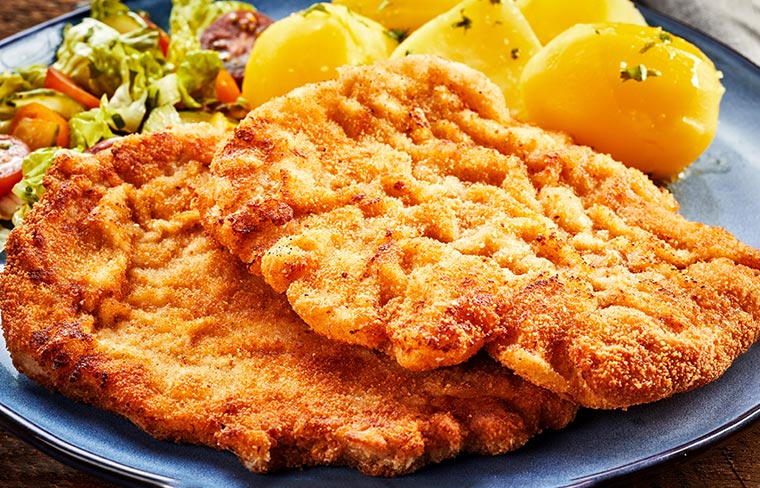
Wiener schnitzel. Apfelstrudel. Sachertorte. Think of Viennese cuisine and visions of such mouthwatering classics jump to mind. You’d be remiss if you visit the historic Austrian city without sampling these delights during WCLC 2022.
The city boasts world-renowned chefs, many of them with a Michelin star or two to their names. You’re in for a gustatory delight whether you’re seeking traditional or contemporary fare between conference sessions.
Once the epicenter of the Habsburg Empire, Vienna is known for an array of hearty traditional dishes such as Viennese sausage, Viennese goulash, and Tafelspitz, a boiled beef broth served with horseradish, root vegetables, spices and minced apples that is often considered the national dish of Austria. It’s said to have been a favorite of Emperor Franz Joseph I.
Pastries also take center stage in Vienna. In addition to apple strudel, some of the more famous staples include sachertorte, a double-layered chocolate with apricot jam in the middle; punschkrapfen an iconic hot pink crumb cake filled with apricot jam and nougat then soaked in rum; and kaiserschmarrn, deep-fried shredded pancakes served with fruit compote. You can find these delights at the dozens of cafes, known as konditorei, sprinkled throughout Vienna, where they are served with coffee in the afternoon.
A favorite breakfast and lunch spot for Andreas Tiefenbacher, a medical resident at Medical University of Vienna, is Ponykarussel. The colorful eatery offers Austrian classics with a modern twist in a “half merry-go-round, half jungle, and a little pleasure den of vices” in the middle of the Prater amusement park.
Dr. Tiefenbacher also offered recommendations for wine tours if time allows, including The Obermann, Heuriger Sirbu or Weinbau Zawodsky.
Michael Grusch, also of Medical University of Vienna, is a fan of Café Kafka, a café near Mariahilferstrasse.
“It is small and cozy and a bit old fashioned,” Dr. Grusch said. “They play good music and serve excellent hummus.”
Schweizerhaus, an historic, rustic beer garden and restaurant dating to the 19th-century, serves a lot of this traditional fare and is located within walking distance of the Messe Wien Exhibition & Congress Center.
The View Cafe-Bar-Restaurant, a relaxed, riverside space with terraces and a more contemporary feel, also serves traditional fare and is within walking distance of the conference center.
Café Central, widely considered the grandest of Vienna’s grand cafés, is a tourist attraction with a long-steady line out its doors. It was once frequented by the likes of Leon Trotsky and Sigmund Freud. Rumor has it that service can be brusque, however, it is reportedly worth it for a huge chunk of apple strudel with vanilla custard and the Viennese version of a cappuccino known as a Melange.
The Palmenhaus, inside Vienna’s world-famous botanical hothouse, is a brasserie with an Austrian-meets-Mediterranean menu, a strong selection of wines by the glass, cocktails, and desserts.
If you’re looking for more contemporary fare, check out Apron, which The Michelin Guide describes as a classic yet modern restaurant not far from the Stadtpark, adjoining the Sofitel Hotel. The Michelin Guide has awarded the eatery one star, and says, “the impressive-looking open kitchen turns out a creative, seasonally influenced menu. The dishes are prepared from top-notch ingredients, beautifully handcrafted to draw out their rich flavors.”
For lighter dishes, consider O’Boufes or TIAN Bistro.
O’Boufes, located in the center of the city next to fine-dining staple Konstantin Filippou, is an industrial chic bistro that serves small plates and natural wines. It’s been described as offering some of the most exciting cooking in the city right now with such dishes as: ox with egg, dashi, hazelnut, and cauliflower; and Mangalica schnitzel with cucumber, anchovies and sour cream.
TIAN Bistro is one of Vienna’s rare vegetarian restaurants, and it too has earned a Michelin star. Founder Christian Halper insists on the use of fresh, seasonal ingredients to create what the Michelin Guide describes as a remarkable depth of flavor.
Meanwhile, Mraz & Sohn, a small neighborhood bistro on the outskirts of Vienna, has earned two Michelin stars. According to the Michelin Guide, it has a sophisticated, modern outlook while maintaining the convivial simplicity at Mraz’s heart. Offerings include a ‘No Risk, No Fun’ tasting menu of internationally influenced dishes. Seasonal Austrian ingredients are used for dishes such as Turkish pide with lardo and pine spruce, grilled asparagus with whey-habanero sauce, cod with kaffir lime beurre blanc and fig-leaf ice cream sandwiches.
Steireck, in Stadtpark, was ranked 12 among the World’s 50 Best Restaurants in 2021 by 50 Best Discovery. In extolling its virtues, the website noted that it sits in a building dating to 1904 with “an uber-contemporary monolithic extension (that) includes mirrored glass walls that magically disappear into the ground in summertime, to make for near al fresco dining.”
Its menus include “rare breeds, unfashionable fish species, near-extinct fruit and vegetable varieties and much more in truly exquisite plates. Notable dishes have included veal cooked over charcoal and served with braised cabbage and artichokes, sunflower and Jerusalem artichoke with lamb sweetbreads, or the char fish cooked tableside in beeswax with yellow carrot ‘pollen’ and sour cream.






